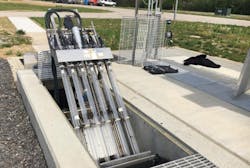Wedeco Duron UV System Key to Future Expansions at Plainfield South WWTP
When Plainfield, Indiana needed to double their permitted capacity from 2 MGD to 4 MGD at their South wastewater treatment plant, they faced a dilemma. Plainfield is on the southwest edge of Indianapolis, and part
of one of the fastest growing counties in Indiana, with growth projections extending well into the future. Like most treatment plants, space is at a premium, and compact design was needed not only for the current expansion, including the addition of a post aeration structure, but to preserve as much room as possible for projected future expansions.
The existing Trojan 3000 UV system was space intensive. It had a very narrow hydraulic operating range that required retaining an existing 30 by 30-foot weir structure. Doing a replacement of this kind, and adding a second unit for the additional capacity was going to consume critical space needed for the future.
Scope
Like most expansions of existing facilities, the hydraulic profile is set and the new processes must fit within that profile. One critical decision was the selection of the post aeration structure. Whitaker Engineering selected an energy efficient low-profile cascade aeration (LPCA) system designed to treat a range of flows from the current low instantaneous flow up to a peak instantaneous flow of 23.2 MGD. That being said, fitting the system into the existing hydraulic profile, expanding the UV capacity and leaving space for future expansions was challenging. Choosing the right UV system was key to making it all work – both today and for tomorrow.
The permit limits call for summer disinfection, April 1st through October 31st, to meet E. coli limits of a monthly average (geometric mean) of no more than 125 colonies per 100 ml and a daily maximum limit of 235 colonies per 100 ml. To meet the diurnal peaks, the UV system needed to treat an instantaneous peak of 9.4 MGD.
Solution
Whitaker Engineering chose a low profile, high-performance Wedeco Duron system. A major factor in the selection was the Duron system’s ability to function over a range of water elevations, up to 3.5 times the range of conventional UV systems. This flexibility allowed the water level for both the UV system and the LPCA to be controlled by a single combination weir gate, eliminating the need for the large weir structure of the existing UV unit. The LPCA could be located immediately downstream of the UV channel, again conserving space for the future.
The Duron system’s high power and energy efficient Ecoray 600W lamps can meet the peak disinfection requirement with only 36 lamps. Whitaker Engineering estimates that the low lamp count, combined with lamp cost and warranties life, will save Plainfield between $5,000 and $6,000 per year in lamp costs alone when compared with the other systems they evaluated. Combined with the 45 degree inclined banks, the low lamp count gives the Duron a very compact footprint, much smaller than the other systems evaluated. In fact, the Duron system more than doubled the treatment capacity while occupying less channel space than the previous Trojan system. This compact footprint left enough space for future expansions including up to three additional UV channels, for a total capacity up to 42 MGD, as well as space for a future generator and sludge beds.
But ask Chief Operator Michael Gillespie what he likes best and he will say the many operational features that make the Duron easy to operate and maintain. The lamp sleeves of the previous system had to be hand cleaned, a difficult task that was made even less pleasant, and potentially dangerous by having to remove the UV system by hand, without even the assistance of a winch. Duron’s automatic wipers, activated by UV intensity sensors, keep the lamps operating at peak performance. No need for hand cleaning – ever!
Michael Gillespie: “The wiper system has worked really well. It has really been foolproof!”
Changing lamps is also quick and easy. The sensors alert the operator when a lamp requires servicing and at the push of a button, the automatic lift raises a bank from the water, while the other banks continue treatment. The entire process is quick and safe. This same automatic lift speeds the annual winterization, lifting the banks out of the channel.
Duron combines energy efficient lamps with real-time monitoring and control to save even more energy. Sensors monitor flow, UV transmittance of the wastewater and UV intensity. Controls adjust the lamp power up or down, or turn banks off and on as needed to maintain optimal dosage delivery as conditions change. This realtime control prevents overdosing for lower energy expenditure, while ensuring compliance. With the Duron system, Mr. Gillespie has never had to worry about compliance reporting, “we typically have results of 40 and under, with a geometric mean of 10 or less.”
Assured compliance, cost and energy efficient, worry free operation and maintenance AND room to grow…..
….the Wedeco Duron system delivered confidence for Plainfield, today and for the future. What can we deliver for you?
Editor's Note: Scranton Gillette Communications and the SGC Water Group are not liable for the accuracy, efficacy and validity of the claims made in this piece. The views expressed in this content do not reflect the position of the editorial teams of Water & Wastes Digest, Water Quality Products and Storm Water Solutions.

